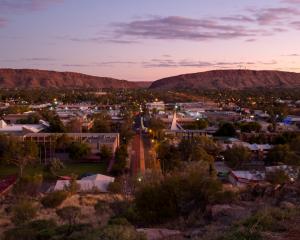As the search for four people on the slopes of Mount Rainier stretches into its second week, experts say the rewards for the hearty few who attempt the summit of the 14,411-foot heavily glaciated volcano in winter are great - as are the dangers.
"The surreal and sublime austerity of being up in the wilderness on the mountain is heightened in the winter," said Stefan Lofgren, mountaineering district ranger in charge of the climbing, search and rescue and aviation programs at Mount Rainier National Park.
Part of the appeal is being able to get further away from everything by heading out in the snow, he said, adding that "the park becomes bigger in the winter time because of the (limited) distance you're able to cover in a day."
Thousands head to the mountain each winter to snowshoe, sled, camp and admire the picturesque views from the park's Paradise visitor's centre, which is open year-round. About 10,000 people attempt to summit the massive volcano each year, but most do so in the summer. Only a few hundred climb in the winter months.
The proximity to Seattle - about a two-hour drive - makes it an easy trip for mountaineers wishing to test their skills. Some climb Rainier in the winter to train for other big peaks such as Mount McKinley in Alaska, while others simply want to tag the top.
"This is seeing the mountain as tough as it can be. If you're up there at Camp Muir in a winter storm, you might as well be on a big mountain like Everest or McKinley. It's a big mountain experience," said Paul Baugher, ski patrol director at Crystal Mountain who has been involved in about 100 search and rescues on Rainier. He was referring to a campsite on a snowfield at the 10,000-foot level.
The elements that draw climbers to Rainier in the winter can make search and rescues challenging, said Mike Gauthier, who was a climbing ranger on Rainier for two decades.
Winter storms on Mount Rainier are frequent, notoriously fierce and obstinate. Crews searching for the missing four people in the past week have been pushed back by winds of up to 60 mph, white out conditions, ice-crusted snow, avalanche dangers and snow depths of between 10 to 15 feet. Avalanche danger, poor visibility, bad weather and darkness can limit searches, experts said.
The four missing people were due off the mountain about a week ago. Mark Vucich, 37, of San Diego, and Michelle Trojanowski, 30, of Atlanta, were planning to camp at the Muir snowfield. Sork "Erik" Yang, 52, of Springfield, Ore., and Seol Hee Jin, 52, from Korea, were on a summit attempt via the Disappointment Cleaver route, the most popular.
Rangers believe both parties were equipped for winter conditions but worry they're running out of supplies. Visitors to the upper mountain were advised to stop moving, dig in and wait out the severe weather and whiteout conditions, and officials hope that's what they've done.
"By far and away, no one has given up hope," Lofgren said Monday, noting that climbing parties have waited out storms for days or weeks.
Weather prevented crews from conducting an aerial search for the two groups, as well as a 66-year-old snowshoer, Yong Chun Kim, who was found alive last week after spending two days in blizzard conditions. Coincidentally, searchers found two other people on Rainier the same day they found Kim; those two had not been reported missing.
Back-to-back search and rescue efforts can also strain manpower when searchers are called to respond to one after another - even highly trained mountaineers who are physically fit, Baugher said. His ski patrollers were among those who found Kim last week.
"It's been a rough month for Mount Rainier," said Gauthier, noting the fatal shooting of a park ranger on New Year's Day in the park and ensuing searches. "Any of these are big events. To have one immediately fall into the next one. It's not even the third week of January. It's a lot of stress on the staff."
Lofgren, who is also a law enforcement park ranger, said he "hit a wall" last week after being involved in the manhunt for the dead ranger's killer, and then the search for Kim.
"It's been incredibly emotionally taxing," Lofgren said of Margaret Anderson's death. "At the end of those days, I felt like I had walked 50 miles."
For those who want to head out to Rainier, Lofgren and others say never underestimate the weather and how quickly it can disorient. "Challenge yourself, but acquire your skill with conservation," he said.
"If everybody dialled it back a notch in these big storms, we might have fewer rescues," Baugher said. "If you're in the mountains, you have to give these winter storms their due respect."













